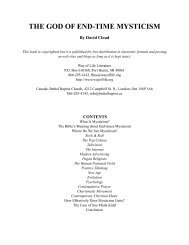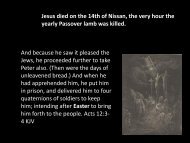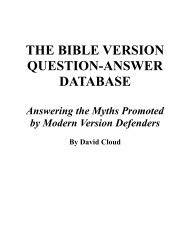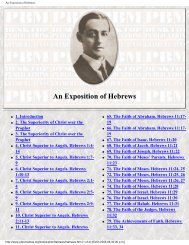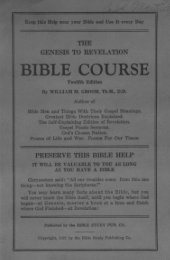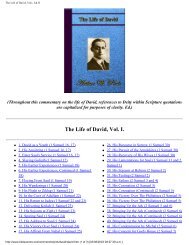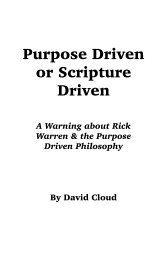A guide to the textual criticism of the New Testament - Holy Bible ...
A guide to the textual criticism of the New Testament - Holy Bible ...
A guide to the textual criticism of the New Testament - Holy Bible ...
Create successful ePaper yourself
Turn your PDF publications into a flip-book with our unique Google optimized e-Paper software.
28 YOUTH.<br />
seeking Him, when <strong>the</strong> seventh verse had made it<br />
clear that<br />
<strong>the</strong>re were three, viz., two <strong>of</strong> CorneHus' servants and a soldier<br />
who was his constant attendant.^ And in Acts xii. 25,<br />
St. Paul and St. Barnabas are said <strong>to</strong> have returned from<br />
Jerusalem <strong>to</strong> Jerusalem, when <strong>the</strong>y were really<br />
going back<br />
from Jerusalem <strong>to</strong> Antioch. Lastly,—not <strong>to</strong> make <strong>the</strong>sj3ecimen<br />
instances <strong>to</strong>o numerous,—<strong>the</strong> Pr<strong>of</strong>essors omit, and <strong>the</strong><br />
Revisers <strong>to</strong>o, '<strong>the</strong> precious verse' (St. Matt. xvii. 21)<br />
*<br />
which declares that this kind goeth not out but by prayer<br />
and fasting,' notwithstanding that only three manuscripts, B<br />
and N and 33, testify by <strong>the</strong>mselves for <strong>the</strong> omission against<br />
a very host <strong>of</strong> varied witnesses.^<br />
This servile submission <strong>to</strong> B, in <strong>the</strong> face <strong>of</strong> copious testimony,<br />
may be also seen in <strong>the</strong>ir presentment <strong>of</strong> proper names.<br />
Such are Melitene for Melita, evidently a transcriptional blunder,^<br />
Nazara in two places only for Nazareth,' Beezebul for<br />
Beelzebul,' Joanes for Joannes,^ <strong>the</strong> uncouth trunks<br />
Koum<br />
and Golgoth,'' and—also a transcriptional mistake—<strong>the</strong><br />
singular appellative Titius Justus.^ They have also, with<br />
'<br />
Also Acts xi. II.<br />
^ Dean Burgon, "The Revision Revised," p. 91, 92, supplies <strong>the</strong>se<br />
witnesses.<br />
Omission <strong>of</strong> verses is very common with <strong>the</strong>se edi<strong>to</strong>rs.<br />
^ MELITIiHNH202. By eliding <strong>the</strong> article »'/, and attaching <strong>the</strong><br />
first syllable <strong>of</strong> i^jjcroc <strong>to</strong> MtX/r??. Acts xxviii. i. See Burgon, "Revision<br />
Revised," p. 177. The letters in <strong>the</strong> oldest Uncial Manuscripts<br />
had no spaces between <strong>the</strong>m.<br />
**<br />
St. ?klatt. iv. 13<br />
and No^rtpar.<br />
^<br />
E. g. St. Matt. X. 25.<br />
: St. Luke iv. 16. They read elsewhere Na^opjf^<br />
^ Though only due <strong>to</strong> <strong>the</strong> scribe <strong>of</strong> B, /. c. also in <strong>the</strong> parts <strong>of</strong> n<br />
written by that scribe. " Introduction," p. 159.<br />
' St. Mark v. 41 : St. Matt, xxvii. :<br />
33 St. Matt. xv. 22 : St. John<br />
xix. 17.<br />
8<br />
ONOMATIIOUiiTOU. Insert a second T between <strong>the</strong> last syl-






